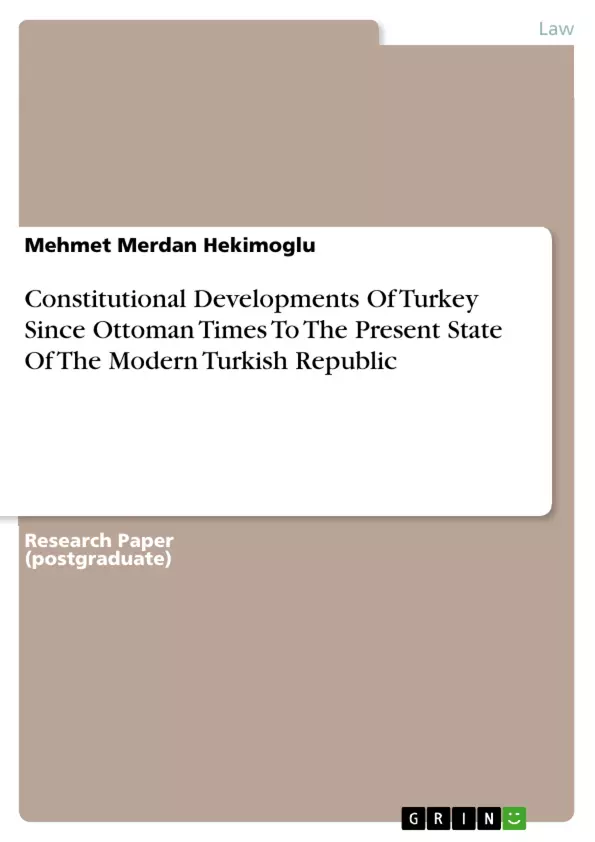This Study concerns itself with the Turkish constitutional developments from Ottoman times to the present state of the modern Turkish Republic.In this way, the historical constitutional experience of the Turkish society will be presented compactly. To this end, first a general overview of Turkish history of law is to be given. The constitutional developments are hereby pointed out from the Ottoman State to the today's Turkish Republic, whereby the respective constitution laws are presented content together. A comparative method will be pursued at this point. Then an introduction is given into the Turkish constitutional amendments in the frame of the EU full membership of Turkey whereby the meaning of these constitutional amendments is shown under the 1982 Constitution of Turkey. Finally, it will be shown that the Turkish people can entirely make a new constitution with only their own natural inner dynamics. The Turkish society, with its rich constitutional experience and its advanced level of development is in a position to do so easily.
Inhaltsverzeichnis (Table of Contents)
- Chapter 1
- CONSTITUTIONAL DEVELOPMENTS IN THE OTTOMAN EMPİRE
- The Ottoman Empire in General
- The Legal System of the Ottoman Empire in General
- Nizam-1 Cedit
- Sened-i İttifak
- Tanzimat Fermanı (Gülhane Hattı Hümayunu)
- Islahat Fermanı
- Kanun-i Esasi (First Constitutional Monarchy)
- II. Meşrutiyet (Second Constitutional Monarchy)
- CONSTITUTIONAL DEVELOPMENTS IN THE OTTOMAN EMPİRE
- Chapter 2
- CONSTITUTIONAL DEVELOPMENTS IN THE TURKİSH REPUBLİC
- The start of the Turkish national liberation war period
- The Constitution of 1921
- The Constitution of 1924
- The Constitution of 1961
- The Constitution of 1982
- CONSTITUTIONAL DEVELOPMENTS IN THE TURKİSH REPUBLİC
Zielsetzung und Themenschwerpunkte (Objectives and Key Themes)
This study examines the evolution of Turkish constitutional developments from the Ottoman era to the present state of the modern Turkish Republic, presenting a concise overview of the historical constitutional experience of Turkish society. This comparative approach demonstrates that Turkey's constitutional experience is not lagging behind other developed Western countries. The key challenge lies in the fact that this experience is not rooted in a substantial sociological movement.
- Historical Overview of Turkish Constitutional Development
- Comparative Analysis of Turkish Constitutional Experience with Other Countries
- Examination of Constitutional Amendments in the Context of Turkey's EU Membership
- The Potential for a New Constitution Based on Internal Dynamics
- The Role of Islamic Law and Turkish Tradition in Shaping Constitutional Developments
Zusammenfassung der Kapitel (Chapter Summaries)
Chapter 1: Constitutional Developments in the Ottoman Empire
This chapter provides a comprehensive overview of the Ottoman Empire, focusing on its history, legal system, and constitutional evolution. It examines key milestones such as the Nizam-1 Cedit, Sened-i İttifak, Tanzimat Fermanı, Islahat Fermanı, and the two constitutional monarchies. The chapter also delves into the unique characteristics of Ottoman law and its application to both Muslim and non-Muslim communities.
Chapter 2: Constitutional Developments in the Turkish Republic
This chapter explores the constitutional changes that occurred following the establishment of the Turkish Republic. It covers the various constitutions adopted throughout the 20th century, including the 1921, 1924, 1961, and 1982 constitutions. The chapter highlights the key features of each constitution and its impact on the political and social landscape of the Republic.
Schlüsselwörter (Keywords)
The main keywords and focus topics of this text include: Ottoman Empire, Turkish Republic, constitutional development, Islamic law, Turkish tradition, legal system, constitutional monarchy, political reform, EU membership, sociological movements, comparative analysis.
- Quote paper
- Mehmet Merdan Hekimoglu (Author), 2010, Constitutional Developments Of Turkey Since Ottoman Times To The Present State Of The Modern Turkish Republic, Munich, GRIN Verlag, https://www.grin.com/document/158150



